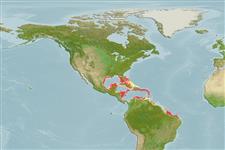>
Ovalentaria/misc (Various families in series Ovalentaria) >
Pomacentridae (Damselfishes) > Chrominae
Etymology: Chromis: Greek, chromis = a fish, perhaps a perch (Ref. 45335).
Environment: milieu / climate zone / depth range / distribution range
Ökologie
seewasser riff-verbunden; standorttreu; tiefenbereich 15 - 116 m (Ref. 13442), usually 15 - 30 m (Ref. 9710). Tropical; 35°N - 23°S, 100°W - 34°W
Western Atlantic: southern Florida, USA and the Caribbean Sea (Ref. 7247) to northern Brazil (Ref. 57756). More abundant at continental locations (Ref. 51183).
Size / Gewicht / Alter
Maturity: Lm ? range ? - ? cm
Max length : 10.0 cm TL Männchen/unbestimmt; (Ref. 9710)
Rückenflossenstacheln (insgesamt) : 13; Rückenflossenweichstrahlen (insgesamt) : 11 - 12; Afterflossenstacheln: 2; Afterflossenweichstrahlen: 11 - 12. Adults gray brown dorsally, often shading white ventrally, with purple- blue markings, many as vertical lines; upper edge of eye bright purple-blue; juveniles blue (Ref. 13442).
Adults occur in steep outer slopes and deeper patch reefs (Ref. 7247). Oviparous, distinct pairing during breeding (Ref. 205). Eggs are demersal and adhere to the substrate (Ref. 205). Males guard and aerate the eggs (Ref. 205).
Life cycle and mating behavior
Maturities | Fortpflanzung | Spawnings | Egg(s) | Fecundities | Larven
Oviparous, distinct pairing during breeding (Ref. 205). Eggs are demersal and adhere to the substrate (Ref. 205). Males guard and aerate the eggs (Ref. 205).
Allen, G.R., 1991. Damselfishes of the world. Mergus Publishers, Melle, Germany. 271 p. (Ref. 7247)
IUCN Rote Liste Status (Ref. 130435)
Bedrohung für Menschen
Harmless
Nutzung durch Menschen
Fischereien: kommerziell; Aquarium: Kommerziell
Tools
Zusatzinformationen
Download XML
Internet Quellen
Estimates based on models
Preferred temperature (Ref.
123201): 23.9 - 28, mean 26.8 °C (based on 126 cells).
Phylogenetic diversity index (Ref.
82804): PD
50 = 0.5000 [Uniqueness, from 0.5 = low to 2.0 = high].
Bayesian length-weight: a=0.01778 (0.00796 - 0.03971), b=2.99 (2.81 - 3.17), in cm total length, based on LWR estimates for this Genus-body shape (Ref.
93245).
Trophic level (Ref.
69278): 3.4 ±0.45 se; based on food items.
Widerstandsfähigkeit (Ref.
120179): hoch, Verdopplung der Population dauert weniger als 15 Monate. (Preliminary K or Fecundity.).
Fishing Vulnerability (Ref.
59153): Low vulnerability (10 of 100).
Nutrients (Ref.
124155): Calcium = 109 [52, 172] mg/100g; Iron = 0.848 [0.493, 1.437] mg/100g; Protein = 18.2 [16.9, 19.4] %; Omega3 = 0.142 [0.080, 0.246] g/100g; Selenium = 29.6 [14.8, 60.0] μg/100g; VitaminA = 147 [42, 500] μg/100g; Zinc = 1.4 [0.9, 2.0] mg/100g (wet weight);
